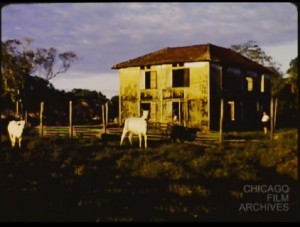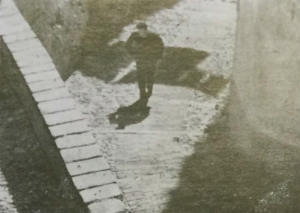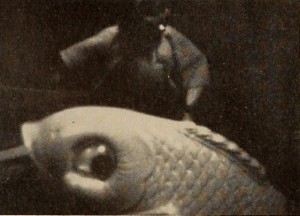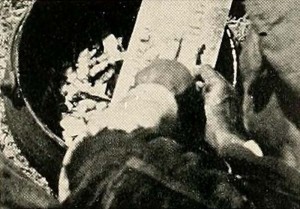"comprises various events of 1932, including shots of the speedboat, Miss England III on Loch Lomond, and a very complete record of the Ulster T.T Motor Race. The reel has been very much in demand and can be hired by anyone, the charge being 4s. for the night" (HMHT 1933: 335).

"2 part edited travelogue film of the people and customs encountered in towns along the Amazon River in South America. Part one includes landscapes, a variety of housing from towns to shacks along the river, people selling goods, trapping and selling exotic animals, herding cattle, boating, and a religious ceremony." Chicago Film Archives.
"Made by F. D. Koehler, jr., ACL, The Mississauga Canoe Trip is a fine example of what the movie maker can accomplish on a hunting trip in capturing a picture that has both good photography and an interesting story presentation. The fact that a tripod was added to the duffel did not daunt this cinematic hunter, and the result is refreshingly rock steady pictures that leave nothing to be desired. Perfect exposure, for the most part, and some excellent lighting show that the maker had an eye for the essentials of good picture making. A knowledge of what makes a good screen picture is demonstrated in the many effective closeups throughout the film. An excellent job of amateur titling is another feature that places this film in a high category for vacation films." Movie Makers, Dec. 1934, 534.

"a sogg. lungh. norm." Feature fiction film
"La Nave, realizzato da Giovanni Paolucci, collaboratore tecnico Pietro Portalupi. Il difetto di questo film consiste nello scenario, nel non aver cioè gli autori trattato il tema in forma meno dispersiva, il protagonista, uomo disorientato ed inutile, senza uno scopo nella vita trova, col lavoro in una nave che alla fine viene varata e nell'atmosfera del fascismo, la sua strada. Un tema simile poteva essere trattato retoricamente o in modo più semplice e persuasivo; gli autori si sono attenuti alla via di mezzo, riuscendo talora in buone sequenze, talora in sequenze dall'azione dispersiva. Migliore è la prima parte, quando Paolucci descrive il rapporto dell'uomo col mare, e prima, la sua solitudine; la fotografia è in queste scene piuttosto notevole."
"The Ship (La Nave), directed by Giovanni Paolucci, technical collaborator Pietro Portalupi. The defect of this film is in the scenario and in its authors not treating the subject in a less unorganized way. The protagonist, a disoriented and useless man, without a purpose in life, finds his way by working on a ship that is eventually launched and in the atmosphere of fascism. Such a theme could have been treated rhetorically or in a simpler and more persuasive way; the authors stuck to the middle ground, succeeding sometimes in good sequences, sometimes in sequences with dispersive action. The first is the best part, when Paolucci describes the man's relationship with the sea, and before that, his loneliness; the photography is quite remarkable in these scenes."
—Il ventuno 28 (Review of the G.U.F. of Venice), May 1935, p. 17-18
"Begins with a close-up intro of the Davis's in a small boat. One of the girls falls overboard and is saved. A woman drops her jewels overboard. Family disembarks. Finds a clue on a piece of paper. The Family sets out in boat with shovels, saws, axes, etc. Quarrel with another family. Find a deed." oldfilm.org
"a war film… deals principally with submarines… an almost full-sized submarine was built out of sheet-iron and wood; the very convincing interior of the aforesaid submarine was built in a garage; and merchant ships (models) were ruthlessly blown up by a torpedo (ditto, bought at Woolworths), which zipped through the water (by a string wound on a Kodak rewind) and left a wicked-looking wash (milk)" (R.S. 1932: 9).
"Sites around Norway." UC San Diego Library.

"Neither the lead title nor the unpretentious opening scenes — as a small boy is seen building a crude toy boat — prepares the spectator for the pure enchantment of One Summer Day. For, almost unrealized even as it happens, the film melts with incredible smoothness from live action into animation and make-believe. The toy boat becomes a pirate galleon of old, a flower a maiden in distress and a twig her gallant suitor, as there unfolds a tale of romantic derring-do. Under cover of darkness, the pirates plot to kidnap the lady, whose protector, a humble fisherman, is away at his nets. He returns, only to be bested in the ensuing sword play, yet, undaunted, he still gives chase. With the help of a friendly whale, he overtakes the pirates, frees his lady and, as the galleon goes down in flames, the lovers return to shore, to live happily ever after. Then, as quietly as it all began, we are back at the edge of the sunlit pond. The boy lifts his boat from the water and turns homeward. And yet, through the true magic of the movies, we have entered for a brief moment childhood's enchanted world. Highly imaginative camera handling, technical skill and a keen sense of cinematic values make this an outstanding example of personal filming. The musical accompaniment and sound effects (including the cling-clang-cling of clashing swords) complement the picture perfectly. Glen Turner has added a new dimension to amateur filming with this simple story so superbly told in its brief 350 feet of 8mm. film." Movie Makers, Dec. 1949, 452-453.

"Porpoise Oil presents a cleverly planned and charming story that shows how the Indians of the upper St. Lawrence region live today and how their ancestors obtained oil from the porpoise of the neighboring bays. Dr. Leighton was fortunate enough to find an old Indian who, in his younger days, had been a champion porpoise hunter and the picture tells in Kodachrome how the fish was shot and the oil tried. This constitutes an important document of Indian craft that, otherwise, in time would be lost to the world. A touch of humor throughout and a surprise ending serve to spice the film and to make it the excellent study that it is instead of a routine record film. The continuity is well developed and the photography is of good quality." Movie Makers, Dec. 1937, 630.
"Racing Stars tells the story of a contest of boating enthusiasts in the Star class of sail boats. The Star is used primarily for racing, is about 23 feet long, has a keel with a 900 pound weight at the bottom, and carries only two sails, a main and a jib. Standards assure similarity of boats, of which there are about 5000 in all parts of the world. An animated diagram shows how Star boats follow the prescribed course in a contest An excellent commentary with superb photography keeps this picture moving with never a let-up, and any landlubber can smell the sea air by the time the picture ends" PSA Journal, Sept. 1964, 50.
Total Pages: 8